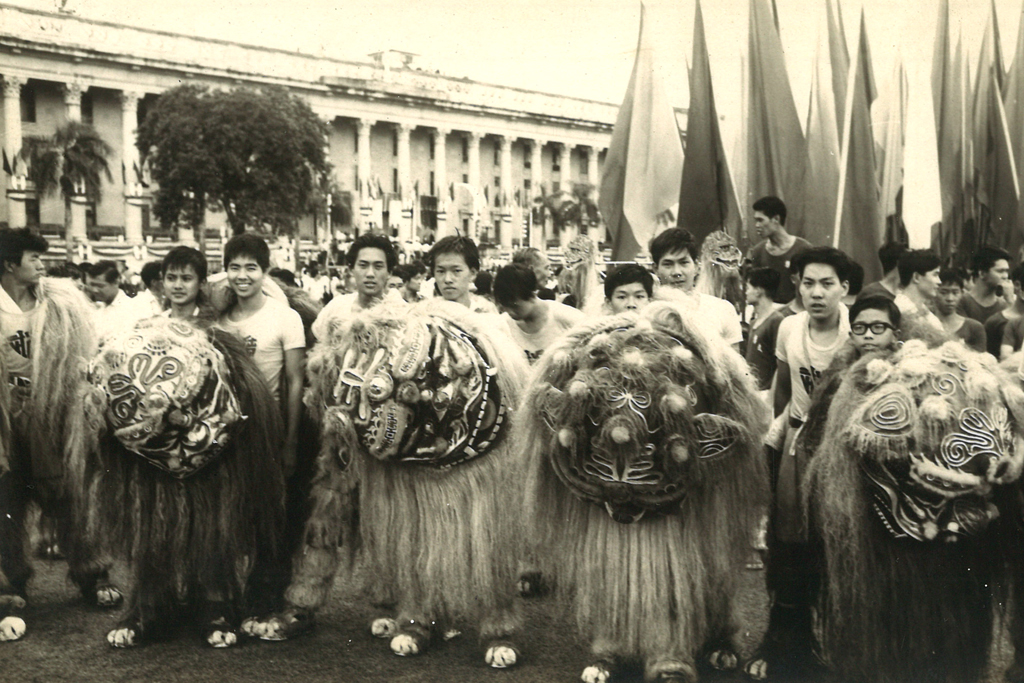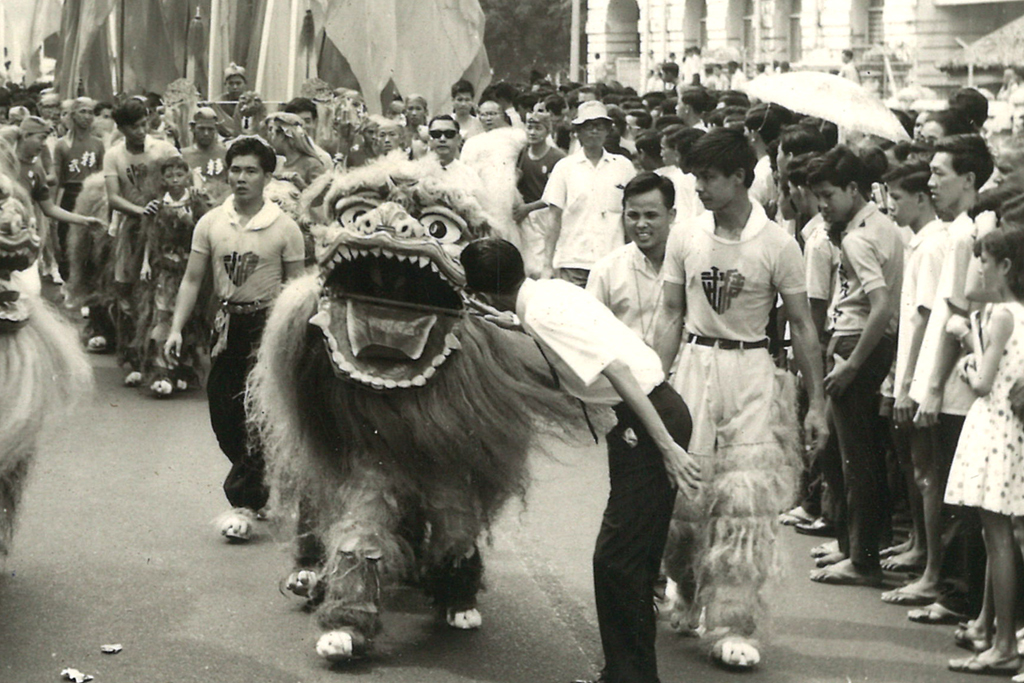We lion danced at the first-ever NDP. Here’s what we remember
For Tan Koon Chuan and Lim Ee Beng, performing in 1966’s National Day Parade (NDP) was one highlight of many from Singapore’s Golden Age of lion dance.
- 5 Aug 2024

Lion dancers at the 1966 NDP. Image courtesy of Chin Woo Athletic Association
Since its inception almost six decades ago, Singapore’s NDP has become a major event of every calendar year.
Way back in 1966, few people could have imagined what an enduring display of national pride it would develop into — including the performers themselves.
Even so, the first NDP was both festive and lavish by contemporary standards, with a theme of "National Pride and Confidence in the Future" reflecting the hopes of a fledgling nation.
Even so, the first NDP was both festive and lavish by contemporary standards, with a theme of "National Pride and Confidence in the Future" reflecting the hopes of a fledgling nation.
Kicked off with a 21-gun salute, NDP ’66 saw a 90-minute march-past of 23,000 Singaporeans, led by six contingents of the People’s Defence Force, and followed by performing student groups from Malay, Chinese, Tamil, and English schools.
Lion and dragon dancers provided a fitting and noisy finale, signaling optimism for Singapore’s future.
Sixty lions and dragons danced that day, with the sounds of cymbals, drums, and gongs filling the Padang.
In fact, it was the biggest assembly of lion and dragon dancers ever in Singapore, and for two dancers from Chin Woo Athletic Association it was part of a long journey with the art form.

Lim Ee Beng and Tan Koon Chuan are the current and former chairmen of Singapore’s historic Chin Woo Athletic Association.
Kidding around
Tan Koon Chuan and Lim Ee Beng, now in their 80s, started lion dancing as teenagers in the early 1960s after watching local performances by Chin Woo.In the early days of Singapore's independence, entertainment for young people was scarce. “There was only the community TV,” recalls Koon Chuan.
Many families feared their children would join gangs from restlessness and encouraged them to take classes at associations like Chin Woo. Its Singapore chapter was founded in 1921 and provided an outlet for youths to take Chinese language classes, learn life skills, and develop hobbies such as martial arts or Peking opera.

Chin Woo’s lions marching towards the Padang. Image courtesy of Chin Woo Athletic Association
New members were drawn to Chin Woo through performances, word of mouth, and the release of martial arts blockbusters, Bruce Lee’s films proving particularly influential in driving recruitment.
However, it was the lion dance that enticed the two young boys most. It would take far longer than either of them expected to put on their first suit.
However, it was the lion dance that enticed the two young boys most. It would take far longer than either of them expected to put on their first suit.
Just dance? Not quite
Traditional lion dance heads were once made of clay and could easily weigh between seven to ten kilogrammes. Even after people began building them with bamboo strips and dyed wool, long and energetic performances could still be grueling.
Ee Beng remains a proudly active Chin Woo member, decades after first joining the Association.
"We had to practice wushu for at least three years first,” says Ee Beng, “to develop the strength, stability, and stamina to perform lion dance well.”
Chin Woo’s lion dance troupe was one of the few to practice in the northern style, with distinctive lions characterised by long fur. Between the 1960s and 1980s, lions from different troupes across Singapore were a regular sight at NDP. But in old photos, “Our long-haired lions stand out immediately,” says Koon Chuan proudly.

A lineup of northern lions at the Padang. Image courtesy of Chin Woo Athletic Association
Birth of the Lion City
Although performers like Ee Beng and Koon Chuan were multitalented and able to tumble, somersault, balance, and dance other styles, the lion dance was by far Chin Woo’s most popular craft due to Singapore’s newly minted independence.The young nation needed to brand itself on the international stage and had chosen to introduce itself as The Lion City. At the government’s invitation, Chin Woo’s Lion Dance troupe traveled for months at a time on diplomatic tours.
The troupe was thrilled to showcase Singapore to the world through their dance.
They loved us everywhere we went. We even performed for Elizabeth II and Deng Xiaoping.

Chin Woo’s distinctive, long-haired northern lions have traveled the world representing Singapore and appeared on banknotes (right, issues in 1976). Images courtesy of Chin Woo Athletic Association
These tours provided a once-in-a-lifetime opportunity to see the world. Some performers even chose to give up stable employment for travel. Others like Koon Chuan decided to stay and work, only joining after-hours practice sessions as a hobby.
Low-key lions
As Singapore has become more urbanised, lion dance has changed. Many Singaporeans are too busy with work, school and life to pick up the art form or devote time to mastering it.Outdoor spaces where the troupe can practice without disturbing residents are also increasingly rare. Part of Chin Woo's refurbishment plans for its headquarters is to create a soundproof, indoor rehearsal space to continue their legacy.
Despite these challenges, the Association is still going strong. Familiar faces who ‘disappear’ tend to return once their children are old enough or when they are retired with more free time to practice dance and martial arts for health benefits.

Chin Woo continues to spread the love of traditional Chinese martial arts and dance among new generations. Images courtesy of Chin Woo Athletic Association
For decades, Chin Woo provided Koon Chuan and Eee Beng a way to stay fit, enjoy performing, and form a community.
I have lots of happy memories just sitting together in a shelter, waiting for the rain to pass so we could rehearse. It almost felt like we were a family.
The benefits of all that practice continue into the present too: “I can stand all day at my hawker stall and
I have no problem at all.”
“We had to wake up very early,” says Ee Beng.
“And it got very hot later in the day while we were marching to the Padang,” says Koon Chuan.
The sixty lions and dragons wrapped up their dances at 10:30, just seven minutes before the heavens opened, bringing some much-needed relief - a lucky break for lucky lions that would become the symbol of a new nation’s fortunes.
Raining on the parade
1966’s NDP was just one career highlight of many for Ee Beng and Koon Chuan, and their recollections of the day are surprisingly matter-of-fact.“We had to wake up very early,” says Ee Beng.
“And it got very hot later in the day while we were marching to the Padang,” says Koon Chuan.
The sixty lions and dragons wrapped up their dances at 10:30, just seven minutes before the heavens opened, bringing some much-needed relief - a lucky break for lucky lions that would become the symbol of a new nation’s fortunes.





.jpg?h=683&w=1024&la=en&hash=A562D3F54ACD95ECA5F9735D88B994EE)
